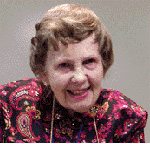
Sarah Estep
(1926 – 2008)
Sarah Estep was a notable figure in the field of Electronic Voice Phenomena (EVP) and
paranormal research. She became interested in the paranormal in 1976 after reading a book that
discussed the work of Friedrich Jürgenson and Konstantins Raudive.
She began recording EVPs using a reel-to-reel tape recorder with no initial responses. For six
days she started her recording by asking “Is anyone here?” without any responses. On day 6 she asked,
“What is your world like?” and got a clear response, “Beauty.”
She continued her EVP recordings and research, then in 1982 she founded the American
Association of Electronic Voice Phenomena (AA-EVP), now known as Association TransCommunication.
Sarah Estep played a pivotal role in founding the AA-EVP, an organization dedicated to the study and
promotion of Electronic Voice Phenomena. Under her leadership, the AA-EVP provided a supportive
community for researchers and enthusiasts to collaborate and share their experiences and findings
related to EVP. She retired in 2000, asking Lisa and Tom Butler to take over the Association.
Estep was a dedicated researcher who conducted extensive EVP experiments. She was known
for her systematic approach to EVP recording and analysis. Her work focused on capturing and
interpreting voices and sounds from the afterlife, contributing to the body of evidence in this field. She
also popularized the classification system originated by Konstantin Raudive using the “Class” system still
used today.
One of Estep’s most significant contributions was the publication of her book, “Voices of
Eternity,” in 1988. Her book detailed her personal experiences with EVP, the methods she used for
recording voices from the afterlife, and her theories about the phenomenon. This publication helped
raise awareness of EVP and brought it to a broader audience. She released a second book, “Roads to
Eternity” in 2005.
Sarah Estep was a vocal advocate for the study of EVP and the existence of an afterlife. She
worked to educate the public about EVP, participating in interviews, giving lectures, and sharing her
knowledge and experiences to promote understanding and interest in paranormal research.
In summary, Sarah Estep’s contributions to paranormal research are notable for her role in
founding the AA-EVP, her dedicated research and experimentation with EVP, the publication of her
book, and her advocacy efforts to promote awareness and understanding of Electronic Voice
Phenomena. Her work continues to impact the field and inspire those interested in exploring the
mysteries of the afterlife.
Links to some of her EVPs:
https://atransc.org/sarah-estep-evp/
https://youtu.be/OXpVZW1lhoM
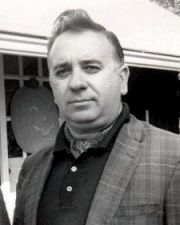
Paranormal Investigator, demonologist, and author.
Report by Candace
Ed Warren was born Sept 7, 1926 in Bridgeport, Connecticut. He grew up in the Roman Catholic religion. His nick name growing up in the rough part of town was, Blood Bucket. Ed served in the US navy in World War II. After the war he attended Art school, and married his sweetheart, Lorraine. He became a Police officer, just as his father before him. But he loved his art. He would do beautiful paintings of homes in the area, only to hear they were haunted. Sometimes he would trade the artwork, for access into these homes. With his courage, religion and his wife with her “gifts”, he set out to help people understand the paranormal. Thus the New England Society for Psychic Research was born.
Ed became a Self-Taught, Demonologist. Yes, I said self-taught. Which alone it’s self is amazing! Ed and Lorraine investigated as many as 1000 cases, in his life time. To include the “Amityville Horror” case and “The Conjuring” case, this later became books, and movies. The lectured quite a bit, even lectured at West Point!
Ed always claimed the raggedy Ann doll was the most dangerous object he ever encountered. He told Harry Smith of “CBS This Morning” “It’s not the doll Harry, It’s what surrounds the doll. Its vibration’s that were put into it through many evil things that were done with it….
Ed wasn’t into just ghost and demons. Ed claimed to have brushes with, bigfoot, vampires, and werewolves. In their spare time the couple would travel to Scotland, and England. They would run ghost tours over there
Ed Warren passed away August 23, 2006. His wife, Loraine still has the couple’s museum, where you can tour and see Ann Belle., the Raggedy Ann doll in the above mentioned paragraph.
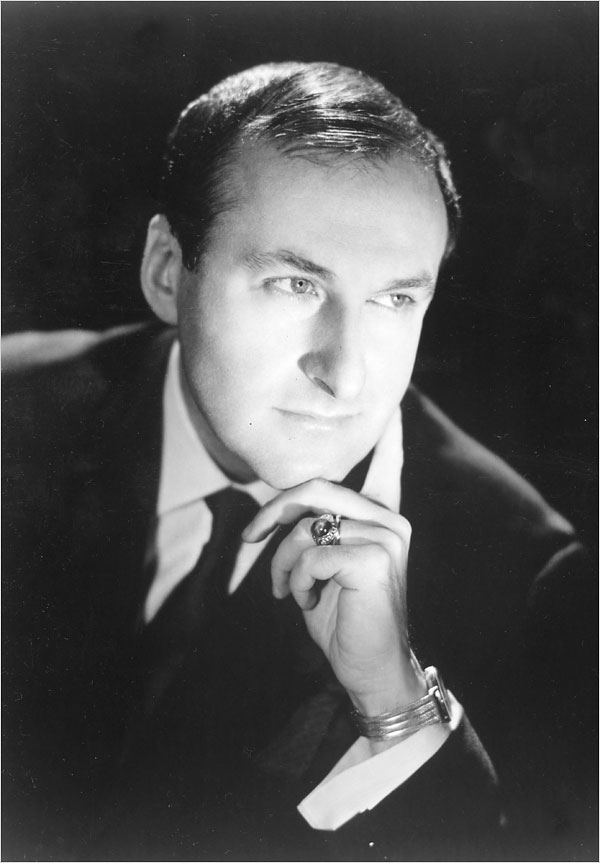
American paranormal researcher and author
Report by Candace
Hans Holzer was an American Paranormal researcher. He was born in Austria in 1920. In 1938 he moved to New York City. Some of the things you might know about Holter is in his lifetime of research he wrote over 120 books on various topics of paranormal. He is the father of the term “the Other Side”.
His most famous case was the Amityville Horror. But did you know, he went to Colombia University to learn Japanese? He also wrote plays, and musicals such as “the Way You Kissed Last night” And The “Kitty Kat Club. He actually called the Church of Scientology” a dangerous Bunch”. He was well rounded man, took a wife and had children.
He had a PHD in Parapsychology from The London College of Applied Science Unlike Most Parapsychologists in his field he studied all of the following, witchcraft, alchemy, UFO’s, Bigfoot, paganism, vampires, and astrology. Most of them do not believe in the above mentioned., but he did.
When on investigations, he always had a psychic on his team. He believed in the communications, from the “other side”, as imprints. Left for gifted people to pick up. Sybil Leek, was one such person he worked with. He had a show called Ghost Hunter{ no not the plumber guys} he was credited with that term as well. Once in an interview he explained his three known dirty words in his vocabulary were: belief, dis belief, and supernatural.
“belief is the uncritical acceptance of something you can’t prove. I work on evidence.”
Hans Holzer passed away in 2009, leaving his daughter, Alexandra Holzer to carry on his lifetime of research.
Personal note: I have read two of his books, “Ghost Hunter” and “The Alchemist “I also have purchased “who killed Curt Cobain” as my next read. I suggest the first one for our field.

{Full name used rarely Nicolas Camille Flammarion}
Born: February 26, 1842 in Montigny-le-Roi, now named Haute-Marne, France
Died: June 3, 1925 in Juvisy-sur-Orge, France
Report by Will
Camille Flammarion was a French astronomer, science fiction author, and spiritism investigator. He has been described as an “astronomer, mystic, and storyteller” who was “obsessed by life after death, and on other worlds.”. He was influenced by Jean Reynaud (1806–1863) and his Terre at ciel (1854), which described a religious system based on the transmigration of souls. Because of his scientific background, he approached spiritism, psychic research, and reincarnation from the viewpoint of the scientific method, writing, “It is by the scientific method alone that we may make progress in the search for truth. Religious belief must not take the place of impartial analysis. We must be constantly on our guard against illusions.” In his writings, he debunked and explained in detail many of the current ploys used by charlatans to deceive clients. He also wrote in intrinsic detail the methods he implemented during paranormal investigations he was chosen to speak at the funeral of Allan Kardec, codifier of Spiritism, on 2 April 1869. Both George Griffith and Edgar Rice Burroughs have references to him in their writing. Sir Arthur Conan Doyle’s The Poison Belt, published 1913, also has a lot in common with Flammarion’s ideas.
More info: http://www.encyclopedia.com/topic/Nicolas_Camille_Flammarion.aspx
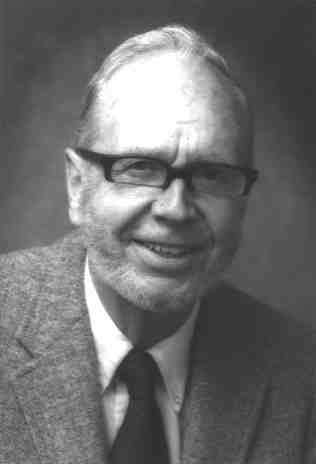
Founder of Metascience Foundation, ITC research, inventor of Spiricom
Excerpts from http://www.worlditc.org/
A retired industrialist who had revolutionized the air-conditioning industry and had made a small fortune on a series of patents, George was intrigued by the life energies that bristled and surged below the surface of our physical world, beyond the range of our five physical senses… and for the most part beyond the range of our scientific and technical instruments. It had also spurred the creation of the Metascience Foundation, Meek’s highly regarded, nonprofit enterprise to analyze the human spirit from a scientific angle. George retired on his sixtieth birthday to fulfill a life-long dream. He began traveling the world with his wife Jeannette to explore the deepest and richest spiritual truths hidden along the backroads of the Twentieth Century world. George was intrigued by the life energies that bristled and surged below the surface of our physical world, beyond the range of our five physical senses… and for the most part beyond the range of our scientific and technical instruments. George knew that these invisible energies played a major part in our lives and in our world, but most people didn’t even know they existed. Even science didn’t acknowledge their existence, and that made George uncomfortable. He committed himself to proving the existence of life energies—of spiritual reality—to a skeptical world. In 1979, he and his colleague Bill O’Neil developed the Spiricom device, a set of 13 tone generators spanning the range of the adult male voice. O’Neil was psychically gifted, and he collaborated with his spirit friends while developing the large radio-like apparatus, which gave off a droning buzz that filled the room. When O’Neil spoke in its presence, you could hear his voice getting wrapped up in the buzzing noises of the Spiricom machine. He worked on the machine for months, and then a most amazing thing happened. Another voice began to get wrapped up in the radio sounds too—a voice belonging to someone who was present in the room, but invisible. The voice of a spirit. The spirit collaborator soon identified himself as Dr George Jeffries Mueller, a college physics teacher who had died in 1967 and had now come close to the vibration of the Earth to assist Meek and O’Neil in opening a communication bridge between the two worlds. O’Neil and Mueller went on to record more than 20 hours of dialog between 1979 and 1982. George himself died in the winter of 1999, after circling the globe many times, acquiring undeniable proof of afterlife, and writing two pioneering books that opened up new markets and blazed the way for a new breed of writers on spiritual matters. George Meek’s two break-out books were Healers and the Healing Process, published in the 1970s, and After We Die, What Then?, published in the 1980s.
More info:http://www.worlditc.org/k_06_spiricom.htm
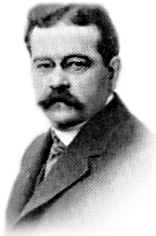
(1874 – 1932)
Fortean: /ˈfôrtēən/ (adj.) of, relating to, or denoting paranormal phenomena.
Charles Fort was an American writer made famous by his research and works relating to anomalous phenomena. Charles spent over thirty years studying phenomena that lay outside of normal theories and belief. For his research, he spent most of his time in the libraries of New York and London and from his thousands of notes, he wrote 4 books that he published, introducing the world to his research into the supernatural and paranormal phenomena.
Charles Fort coined the phrase Chain Lightening and is often credited with coining Teleportation. Many believe that he was the first person to explain human disappearance with the theory of Alien Abduction and was an early advocate of the theories of extraterrestrial hypothesis as an explanation for unexplained lights in the skies. Some of his other studies and subject of writings included poltergeists, fish and frogs raining from the skies, spontaneous fires and levitation. Most of these theories that Charles Fort studied and wrote about are now considered Fortean Phenomena and many have been broken into individual schools of study, including Ufology and Cryptozoology. Though most scientists and academics do not recognize these studies, by many Charles Fort is considered one of the first founders of Paranormal Study and many Fortean groups still exists to this day, dedicated to carrying on his research.
More info: http://en.wikipedia.org/wiki/Charles_Fort
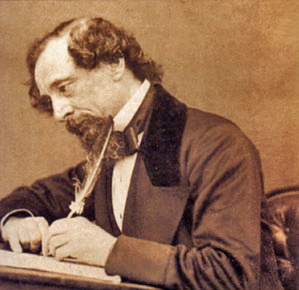
Paranormal Investigator
February 7,1812 – June 9,1870
In 1862, the first organized group for paranormal investigation was founded in London, named “The Ghost Club”, its prime interest focused on paranormal phenomena such as ghosts and hauntings. The club has its roots in Cambridge when in 1855, fellows at Trinity College began to discuss ghosts and psychic phenomena. Formally launched in London in 1862 (attracting some lighthearted ridicule in “The Times”), it counted amongst its early members Charles Dickens and Cambridge academics and clergymen. One of the club’s earliest investigations, in 1862, was of the Davenport Brothers’ “spirit cabinet”. The Ghost Club was challenging the brothers’ claim to be contacting the dead, a claim that was later proved to be a hoax. The results of that investigation, though, were never made public.
On June 9th, 1865, while returning from Paris with his wife, Dickens was involved in the Staplehurst rail crash in which the first seven carriages of the train plunged off a cast iron bridge that was being repaired. The only first-class carriage to remain on the track was the one in which Dickens was traveling. Dickens spent some time trying to help the wounded and the dying before rescuers arrived. Before leaving, he remembered the unfinished manuscript for “Our Mutual Friend”, and he returned to his carriage to retrieve it. Typically, Dickens later used this experience as material for his short story, “The Signal-Man”, in which the central character has a premonition of his own death in a rail crash. Dickens would go on to suffer a mild stroke in 1869 and then, after suffering a second stroke in 1870, passes away never regaining conscientiousness.
“The Ghost Club” undertook practical investigations of spiritualist phenomena, which was then much in vogue and would meet and discuss ghostly subjects. “The Ghost Club” seems to have dissolved in the 1870s following the death of Dickens. However, The Ghost Club reorganized in the early 1880’s. Another famous member of “The Ghost Club” was Sir Authur Conan Doyle, creator of Sherlock Holmes. “The Ghost Club” is still an active organization today in the UK.
Thanks to Hoosier Paranormal for the great article
http://hoosierparanormal.com/

“Inventor of the mel-meter”
By Lisa
Gary Galka is an award winning paranormal investigator and and inventor. He invented the Mel-Meter 8704 and the RT EVP Detector after the sudden and tragic death of his daughter Melissa (1987-2004) she was terribly injured in a car crash 9/24/2004 and past away 9/28/2004. After several unexplained experiences after her passing the family believed was Melissa was reaching out to them, so Gary sat down and designed the Mel-Meter 8704. One of the greatest tools for the paranormal community.

February 11, 1847 – October 18, 1931
“Telephone to the dead”
By Jeff
Mr. Edison has been credited with many inventions, none of which has been as controversial as his supposed plans for the “telephone to the dead”. These plans have never been found. Near the last legacy of his life he, like many of us, struggled with how a spirit exists after the earthly shell is gone. There were numerous references throughout his diary to his either fascination or sheer obsession with this device. We don’t know if the reason was a loved one or friend who had died previously, fueling his passion. Mr. Edison stated he believed that “life units would simply form other things”, a reincarnation if you will. As simple physics tells us, matter is not created or destroyed but is simply changed. He was convinced that these “life units” invaded every aspect of life, plants and animals. Mr. Edison also felt that the personality of these units existed after death and that if correct, would be able to show that personality thru some form of contact via electronic means. We know a device was in the process of being made, he referred to it several times as the “telephone to the dead”.“The Edison estate has repressed these documents along with others until it was shipped to Rutgers University” Why were these repressed? Perhaps not to shed a bad light on Mr. Edison, the inventor. We know that something is out there, we know that thru modern day electronics and old ways we attempt to communicate with them and sometimes receive responses we like and sometimes scare us. Many reports have surfaced throughout the years, stating people have seen numerous things via white noise in TVs, heard thru radios etc. Since our bodies contain electrons, this writer believes that those electrons are energy and it is possible that Thomas Edison was the father of many of our devices. One wonders if he is now part of his own experiment. Does he attempt to communicate thru his own or our devices? A trip to his work shop may reveal secrets that he took to his grave with him. The world may never know.
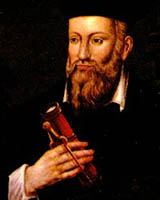
Psychics in history
By Leslie
Throughout history, psychics have been both esteemed and scorned, their powers a subject of both belief and cynicism. Yet, whether psychic powers are genuine or false, psychics have played a significant role in shaping world history. In centuries past, kings planned marriages and waged battles on the advice of their seers.
Michel de Nostradamus One such psychic, Michel de Nostradame (1503-1566), commonly known as Nostradamus, prophesized both natural events, such as droughts and earthquakes and political events such as assassinations and wars. Although supporters link many of his predictions to current events, because his prophecies were undated and are subject to both poor translation and misinterpretation, they aren’t justified as evidence of true psychic power. Yet, the prophecies of Nostradamus remain subjects of speculation by both scholars and popular culture. In Shakespeare’s play, Hamlet (circa 1600), the Dane was visited by the spirit of his dead father, further evidence that belief in psychic phenomena is centuries old. This belief that the dead may contact the living is also a basic tenet of Spiritualism, a religion founded in the 19th Century. Followers of Spiritualism believe that a medium is the psychic intermediary, which spirits use to contact the dead. This is in accord with the common definition of “medium”, something between two extremes (the living and the dead) or something that intervenes to transmit something else, such as a message from a spirit to a living loved one.
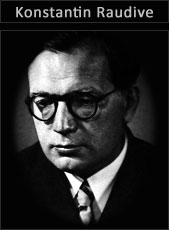
EVP research
By Mark
Many paranormal investigators today would not know what he did for the paranormal field but we still use his techniques and methods today. Konstantin Raudive was a pioneer in E.V.P., electronic voice phenomena. Raudive developed several different approaches to recording evp’s including using a recorder with no one around, using a recorder with a radio not tuned to any station (white noise) and also using a recorder to record through, essentially, a crystal set.
Born in Latvia, Raudive was a psychologist and a parapsychologist when he became interested in e.v.p. soon after Frierich Jürgenson released his book “Voices from space”. He then worked with Jürgenson to make some EVP recordings, but their first efforts bore little fruit, although they believed that they could hear very weak, muddled voices. According to Raudive, however, one night, as he listened to one recording, he clearly heard a number of voices. When he played the tape over and over, he came to believe he understood all of them. He thought some of which were in German, some in Latvian, some in French. The last voice on the tape, according to Raudive, a woman’s voice, said “Va dormir, Margarete” (“Go to sleep, Margaret”). Raudive later wrote “These words made a deep impression on me, as Margarete Petrautzki had died recently, and her illness and death had greatly affected me.”
Raudive spent the last ten years of his life doing research and collected over 100,000 evp’s in strict laboratory conditions and also wrote the book “Breakthrough: an amazing experiment in electronic communication with the dead” which outlined a number of characteristics of the recorded voices.
Raudive delineated a number of characteristics of the voices, (as laid out in Breakthrough):1. “The voice entities speak very rapidly, in a mixture of languages, sometimes as many as five or six in one sentence.”
2. “They speak in a definite rhythm, which seems forced on them.”
3. “The rhythmic mode imposes a shortened, telegram-style phrase or sentence.”
4. Probably because of this, “… grammatical rules are frequently abandoned and neologisms abound.”
Raudive spent the last years of his life in Germany and passed away in 1974 at 64 years old. Next time your listening to your recordings of an investigation think about this pioneer and how difficult it must have been learning this technique.
